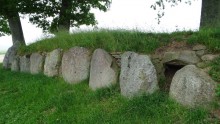|
|
|
|
KarlsmindeLong Barrow
|
||||||||||||||||||
|
|
|
Images (click to view fullsize) |
|
Photographs:












 Maps / Plans / Diagrams:
Maps / Plans / Diagrams:

|
Fieldnotes |
|
|
This site is a well-preserved, west-east orientated long barrow (in German Hünenbett oder Langbett). There are three dolmens on the southern long side. Under the supervision of the State Office for Prehistory and Early History, it was examined and restored between 1976 and 1978 by the working group Arbeitsgemeinschaft Vor- und Frühbeschichte of the Heimatgemeinschaft Eckernförde e.V.. Much of the 108 enclosure stones of the rectangular long barrow were preserved. The foundations of missing stones had to be localized by their foundations. Some stood in situ on the south side. Most of the curbs, however, were tilted outwards and were covered by the spreading hills. After the restoration, the dimensions of the site were 60 x 5.5 m, with a height of up to 2.5 m. The 3 dolmens lying across the long barrow are all on the southern long side. The middle dolmen was only discovered during the restoration work. It was found that the dolmen was originally in a round hill, which was later integrated into the long barrow. From Eckernförde you drive the Waabser Chaussee road towards Waabs. After about 5 kilometers, turn right towards Karlsminde. The site with its own parking lot is located after 500 m directly to the left of the street. Highly recommended, if you are in the area! P.S.: The image stabilizer on my camera didn't work properly on this tour, so some of my images are unfortunately out of focus. Sorry for that. Visited June 2020 |
5th July 2020ce Edited 5th July 2020ce |
|
taken from the on-site Megalithic Routes in Schleswig-Holstein information board: The restored long barrow of Karlsminde This burial site was restored in 1976-1978 by the working group Arbeitsgemeinschaft Vor- und Frühbeschichte of the Heimatgemeinschaft Eckernförde e.V. with a lot of voluntary support. Cooperation with archaeologists and conservationists made it possible to carry out an exemplary project to preserve a megalithic tomb. The goal of the restoration was the exemplary reconstruction of a possible condition of long barrow in the Neolithic period. Landscape shaping Schleswig-Holstein: the flat north of Germany? Not everywhere! The ice ages shaped Schleswig-Holstein's surface. As flat as the marshland in the west is, the hills in the east are wavy. However, some minor elevations were not caused by the ice ages. They do not easily fit into the natural environment. But once the search is known, it is recognizable everywhere in the landscape: they are megalithic tombs. In many places they are also clustered in groups. Some are elongated, others are circular. Their stand positions in well-exposed places like here are also outstanding. This place was also unmistakable in the Neolithic period. So graves became markings of areas of influence of the burying group. As obvious landmarks, the megaliths were later used as landmarks. For example, Bronze Age trails, such as the Ox Trail, and burial sites are often close to the megalithic tombs of the Neolithic. |
5th July 2020ce |

